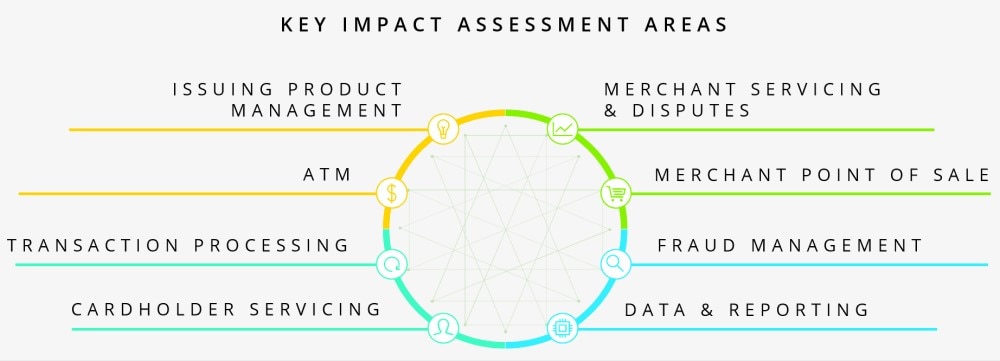Preparing for 8-digit BINs has been saved
Perspectives
Preparing for 8-digit BINs
What issuing BIN expansion means for the payments industry
The number of credit card issuers has grown exponentially in recent years, leading to an expected shortage of available Bank Identification Numbers (BINs). ISO is now calling for issuing BIN expansion from six to eight digits. With Visa and Mastercard committed to 8-digit BINs by April 2022, the entire payments industry should start preparing now.
What issuing BIN expansion means for the industry
After April 2022, the payments industry will be operating with both 6- and 8-digit BINs. Most payments organizations will need to update processes and systems to support the new issuing BIN length and avoid compromising customer service and cardholder protection. The level of preparation will vary significantly depending on how the issuing BIN is used, ranging from limited adjustments to broad changes across multiple functional areas and IT systems.
For example, some acquiring banks use the issuing BIN to route transactions for authorization. To account for the updated issuing BIN length, acquiring banks need to consider a range of potential impacts, including BIN reference tables, coding and configuration of underlying applications, and point-of-sale systems.
While the level of preparation will vary, participating in the payments ecosystem after April 2022 will require the ability to process 8-digit BINs. All payments industry organizations should begin now by conducting a comprehensive impact assessment across the entire organization and suite of supporting applications to help mitigate risks and inform the scope, resource requirements, and timeline for implementing necessary changes.
New issuing BIN number ISO guidance and industry adoption
The payments industry’s next “Y2K event” is right around the corner.
Is your organization prepared for 8-digit BINs?
In response to a sharp increase in the number of card issuers, the International Standards Organization (ISO) has announced an expected shortage of novel combinations for Issuer Identification Numbers (IINs), commonly referred to in the industry as the issuing Bank Identification Number (BIN). Revising their official guidance (ISO/IEC 7812-1), ISO is now calling for an expansion of the issuing BIN from six to eight digits. While the length of the primary account number (PAN) will remain variable (ranging from 10 to 19 digits) the issuing BIN change will require action across the entire payments industry, including banks, processors, fintechs, and the vendors who support them.
The parallels to Y2K are easy to draw. A widely used numeric is expanding by two digits, creating the need to first identify, then address potentially wide-sweeping operational and technology impacts.
And while April 2022 may appear to be in the distant future, there is significant risk for payments organizations who fail to put an issuing BIN expansion plan in place now. Download the full report to learn more.
Visa and Mastercard recently confirmed their support of ISO’s revised guidance and plan to adopt the new standard in 2022. Both networks have stated that acquirers and acquirer processors will need to be ready to operate on 8-digit BINs. After April 2022, Visa will only issue 8-digit BINs. Mastercard will issue 8-digit BINs after April 2022, but has not set a date for discontinuing issuance of 6-digit BINs.
Mastercard has also announced that by 2022, issuers will need to enable account ranges, and acquirers should be ready to operate on 8-digit BINs and 11-digit account ranges.
Other major networks, including American Express, Diners Club/Discover, and China Union Pay, have not announced timelines for adopting the new 8-digit BIN.
The issuing Bank Identification Number (BIN) is the first 6 digits – and with this change, 8 digits – of the Primary Account Number (PAN), located on credit, debit, and prepaid cards. The issuing BIN is used globally to identify the bank that issued the card. Issuing banks can have more than one issuing BIN (most do), but each unique issuing BIN can only be licensed by a single issuing bank.

Critical next steps in preparing for the 8-digit BIN

Assemble a working team across your entire organization
Ensure ongoing communication across lines of business and geographies. Even if operations and supporting applications are different, there are still valuable opportunities to share learnings and identify cross-functional impacts.

Identify and engage impacted vendors
Identify impacts and required updates for vendors. For your organization to be ready, vendors that support key capabilities also need to be prepared.

Assess the use of the issuing BIN across systems and operations
Many payments organizations use the issuing BIN not only in core processing, but also across supporting functional areas such as data analytics and reporting.

Conduct an in-depth product portfolio review
Issuers can use this change as an opportunity to revisit outdated legacy practices, such as PAN randomization starting at the seventh digit, and realign issuing BIN usage with product portfolio strategy. Issuers can also identify and return unused account ranges to simplify conversion to 8-digit BINs and reduce issuing BIN-related fees.

Conduct a review of ATMs and POS terminals
Acquirers should review hardcoded terminal logic and issuing BIN reference data to enable transaction processing and other services.

Alert clients of potential impacts
Informing merchants and cobrand card partners about possible changes due to 8-digit BINs may help reveal unforeseen requirements. Proactive communication will also serve as an opportunity to partner with clients and support them through this industry change.
The payments sector is constantly evolving and reinventing itself, but the broad, global nature of the 8-digit BIN expansion makes it unlike most industry changes. Every organization that uses issuing BINs will be affected, and all industry players need to act now to understand the risks and prepare for this significant change.
Recommendations
Global payments remade by COVID-19
Scenarios for the global payments ecosystem






Latest news from @DeloitteUS
Sharing insights, events, research, and more